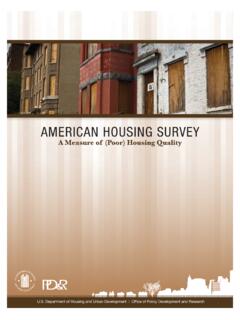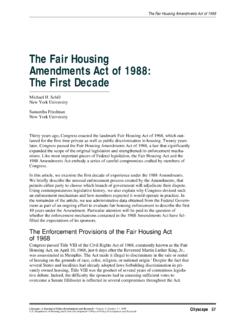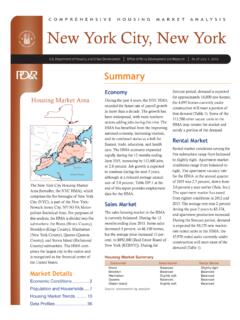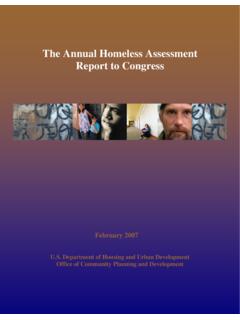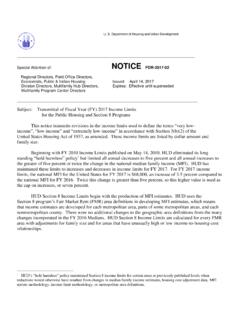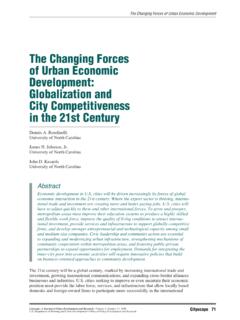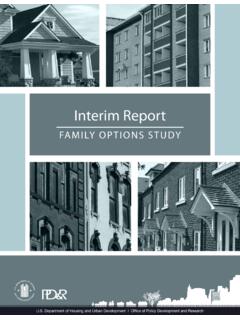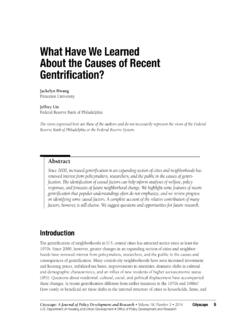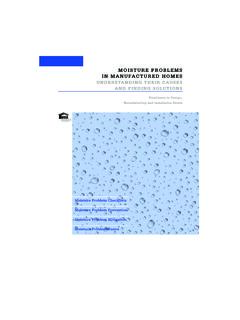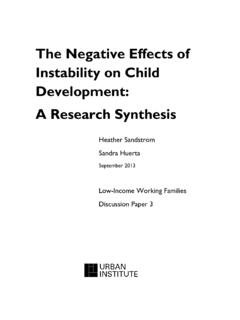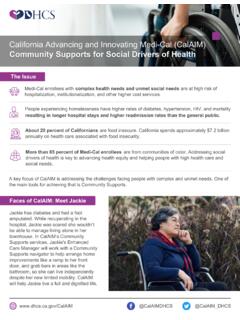Transcription of The 2020 Annual Homeless Assessment Report (AHAR) to …
1 The 2020 annual homeless assessment report (AHAR) to CongressJANUARY 2021 PART 1: POINT-IN-TIME ESTIMATES OF HOMELESSNESSThe Department of housing and Urban DevelopmentOFFICE OF COMMUNITY PLANNING AND DEVELOPMENTA cknowledgementsAUTHORS: Meghan Henry, Tanya de Sousa, Caroline Roddey, Swati Gayen, and Thomas Joe Bednar, Abt AssociatesPRINCIPAL INVESTIGATORS: Dr. Jill Khadduri, Abt Associates, and Dr. Dennis Culhane, Professor of Social Policy, University of PennsylvaniaDATA COLLECTION MANAGERS: Anna Robinson and Azim Shivji, Abt AssociatesDATA COLLECTORS AND REVIEWERS: Thomas Baker, Thomas Joe Bednar, Hanna Carr, Ciara Collins, Jill Cusick, Tanya de Sousa, Ariel Edelman, Swati Gayen, Nathan Greenstein, Meghan Henry, Rachel Jollie, Anna Mahathey, Brendan Ng, Stephanie Reinauer, Caroline Roddey, Jason Rodriguez, Micah Webster, Abt AssociatesPROGRAMMERS/ANALYSTS: Tom McCall and Azim Shivji, Abt Associates, and Jon-Paul Oliva, GIS and Data Quality ConsultantREVIEWERS.
2 Karen DeBlasio, William Snow, and Harper Sutherland, Department of housing and Urban DevelopmentDESIGN AND PRODUCTION: David Dupree, Abt AssociatesContentsKey Findings ..1 Definition of Terms ..2 About this Report ..4 SECTION 1 Homelessness in the United States ..5 National Estimates ..6 State Estimates ..10 Estimates by CoC ..14 SECTION 2 Homeless Individuals ..18 National Estimates ..18 State Estimates ..22 Estimates by CoC ..26 SECTION 3 Homeless Families with Children ..30 National Estimates ..30 State Estimates ..34 Estimates by CoC ..38 SECTION 4 Unaccompanied Homeless Youth.
3 42 National Estimates ..42 State Estimates ..46 Estimates by CoC ..48 SECTION 5 Homeless Veterans ..52 National Estimates ..52 State Estimates ..56 Estimates by CoC ..60 SECTION 6 Chronically Homeless Individuals ..64 National Estimates ..64 State Estimates ..66 Estimates by CoC ..70 SECTION 7 National Inventory of Beds ..74 Appendix ..80ii1 Key FindingsOn a single night in 2020, roughly 580,000 people were experiencing homelessness in the United States. Six in ten (61%) were staying in sheltered locations emergency shelters or transitional housing programs and nearly four in ten (39%) were in unsheltered locations such as on the street, in abandoned buildings, or in other places not suitable for human habitation.
4 For the fourth consecutive year, homelessness increased nationwide. Between 2019 and 2020, the number of people experiencing homelessness increased by two percent. This increase reflects a seven percent increase in people staying outdoors, which more than offset the modest ( ) decline in people staying in sheltered locations. Nearly 6 of every 10 people experiencing unsheltered homelessness did so in an urban area, with more than half of all unsheltered people counted in the Continuums of Care (CoCs) that encompass the nation s 50 largest cities (53%). More than one in five people who experienced unsheltered homelessness was in a CoC with a largely suburban population (22%), and one in five was in a largely rural area (20%).
5 2020 marks the first time since data collection began that more individuals experiencing homelessness were unsheltered than were sheltered. Between 2019 and 2020, the number of unsheltered individuals increased by seven percent while the number of sheltered individuals remained largely unchanged. Increases in the unsheltered population occurred across all geographic number of unsheltered people in families with children increased for the first time since data collection began. In 2020, just under 172,000 people in families with children were experiencing homelessness. While most people in families with children were in sheltered locations (90%), the number of unsheltered people in families increased by 13 percent.
6 This increase offset a decline in sheltered people in families with children, so the overall level of family homelessness was essentially the same in 2020 as in 2019. Between 2019 and 2020, the number of unsheltered veterans increased by six percent, offset by a three percent decline in sheltered veterans. Overall, the number of veterans experiencing homelessness remained unchanged, following considerable reductions in the population in prior years. Increases in unsheltered veterans occurred in all geographic types. On a single night in 2020, 34,000 people under the age of 25 experienced homelessness on their own as unaccompanied youth.
7 Most (90%) were between the ages of 18 and 24. Compared to all individuals experiencing homelessness, unaccompanied youth were more often non-white (52% of youth vs. 46% of all individuals), Hispanic/Latino (25% vs. 20%), female (39% vs. 29%), or identifying themselves other than as male or female (4% vs. 1%).The number of individuals with chronic patterns of homelessness increased by fifteen percent between 2019 and 2020. While increases were reported among both sheltered and unsheltered populations, the sizable increase in the number of unsheltered people with chronic patterns of homelessness (21%) was the key driver.
8 African Americans and indigenous people (including Native Americans and Pacific Islanders) remained considerably overrepresented among the Homeless population compared to the population. People identifying as black or African American accounted for 39 percent of all people experiencing homelessness and 53 percent of people experiencing homelessness as members of families with children but are 12 percent of the total population. Together, American Indian, Alaska Native, Pacific Islander and Native Hawaiian populations account for one percent of the population, but five percent of the Homeless population and seven percent of the unsheltered population.
9 In contrast, 48 percent of all people experiencing homelessness were white compared with 74 percent of the population. People identifying as Hispanic or Latino (who can be of any race) are about 23 percent of the Homeless population but only 16 percent of the population Homeless Individual refers to an individual with a disability who has been continuously Homeless for one year or more or has experienced at least four episodes of homelessness in the last three years where the combined length of time Homeless on those occasions is at least 12 Homeless People in Families refers to people in families in which the head of household has a disability and has either been continuously Homeless for one year or more or has experienced at least four episodes of
10 Homelessness in the last three years where the combined length of time Homeless on those occasions is at least 12 months. Continuums of Care (CoC) are local planning bodies responsible for coordinating the full range of homelessness services in a geographic area, which may cover a city, county, metropolitan area, or an entire Shelter is a facility with the primary purpose of providing temporary shelter for Homeless describes a person who lacks a fixed, regular, and adequate nighttime Inventory Count (HIC) is produced by each CoC and provides an Annual inventory of beds that assist people in the CoC who are experiencing homelessness or leaving homelessness.
